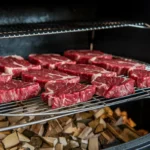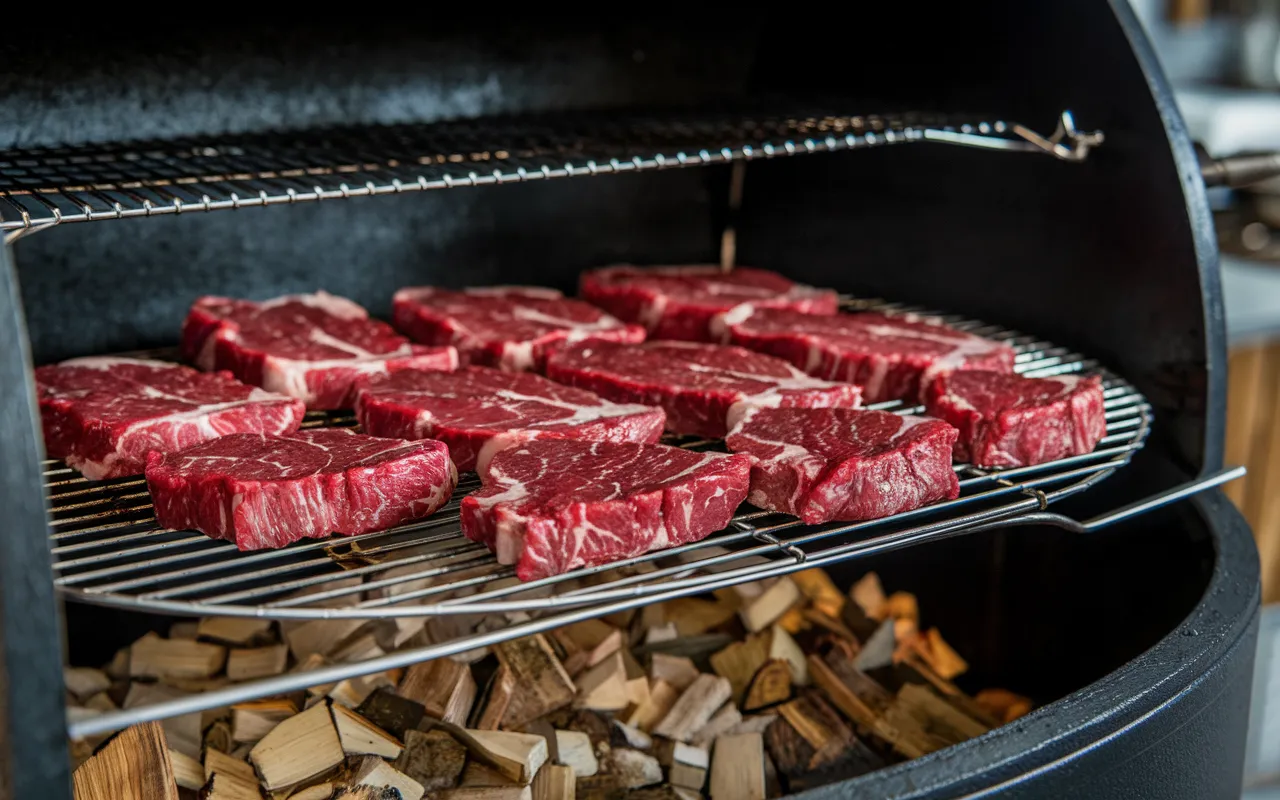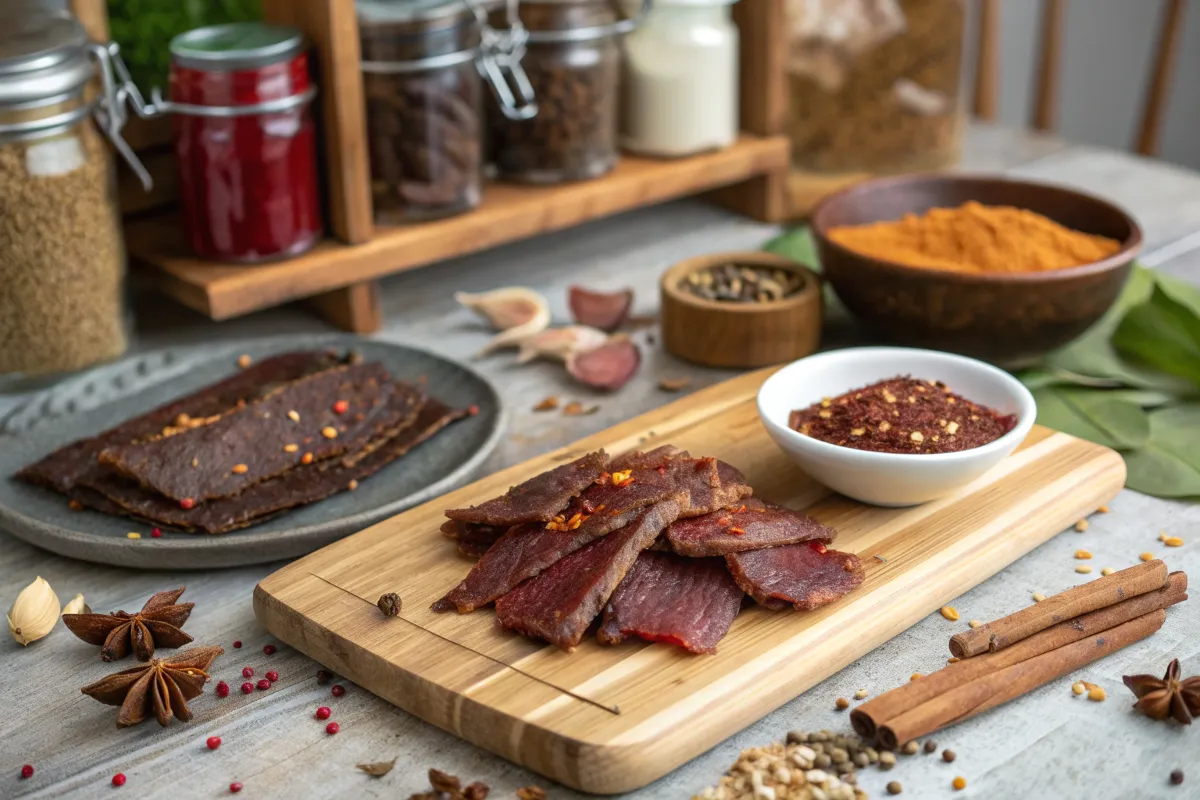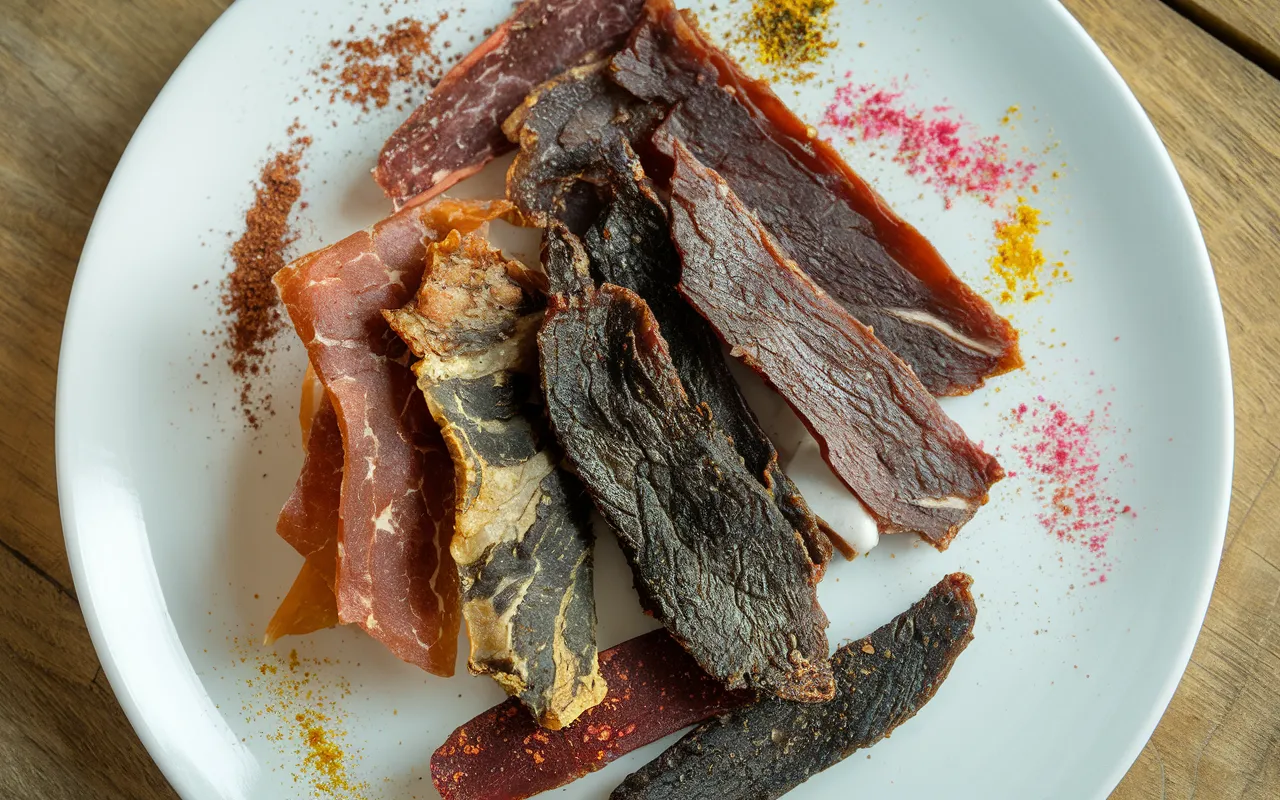Making delicious smoked beef jerky at home is easier than you think. This guide provides a simple yet comprehensive smoked beef jerky recipe. Learn how to create flavorful, chewy jerky using a smoker. It’s a great way to enjoy a tasty, protein-rich snack.
The Basics of a Great Smoked Beef Jerky Recipe
Creating excellent smoked beef jerky involves a few crucial steps. First, you’ll need to select the right cut of meat. Second, preparing the marinade is vital for flavor. Third, proper smoking is key to achieving the perfect texture. Fourth, you will need to dry the jerky properly. Finally, storing your jerky is important for freshness.
Choosing the Right Meat for Smoked Beef Jerky
The type of beef you choose significantly impacts the final product. Lean cuts, such as flank steak or top round, work best. These cuts have less fat, which prevents the jerky from becoming greasy. Additionally, choose a cut that’s uniform in thickness for even drying. Furthermore, trim any visible fat. This will result in a better smoked beef jerky. Additionally, consider the cost of your chosen cut. Sometimes, less expensive cuts can be equally suitable if they meet the leanness requirements. Therefore, take your time when selecting the perfect beef cut.
Preparing the Marinade for Smoked Beef Jerky
A good marinade is very important. It not only adds flavor but also helps tenderize the meat. A basic marinade can include soy sauce, Worcestershire sauce, and your favorite seasonings. For example, you might add garlic powder, onion powder, and black pepper. Moreover, you could include brown sugar for a touch of sweetness. Let the meat marinate for at least 4 hours or preferably overnight. Consequently, the longer it marinates, the more flavor it absorbs. Indeed, some recipes even recommend a 24-hour marination period for very intense flavor.
Key Marinade Ingredients for Smoked Beef Jerky
-
Soy sauce: Provides a salty, savory base.
-
Worcestershire sauce: Adds depth and umami flavor.
-
Garlic powder: Enhances the savory notes.
-
Onion powder: Contributes to the overall flavor profile.
-
Black pepper: Adds a touch of spice.
-
Brown sugar: Balances the savory with sweetness.
-
Liquid smoke: Intensifies the smoked flavor.
-
Optional ingredients include red pepper flakes, honey, or ginger.
-
Consider adding a splash of your favorite hot sauce for an extra kick.
Slicing the Beef for Smoked Beef Jerky
After marinating, slice the beef against the grain. This will ensure a tender, easier-to-chew jerky. Aim for slices about 1/8 to 1/4 inch thick. Accordingly, slicing the meat evenly is important for uniform drying. Therefore, use a very sharp knife or a meat slicer. Also, you can partially freeze the meat before slicing it for better control and more even cuts. Furthermore, uniform slices help to guarantee that the smoked beef jerky dries evenly.
The Smoking Process for Your Smoked Beef Jerky Recipe
Smoking is what gives beef jerky its distinct flavor. Follow these steps for the best results:
Setting Up Your Smoker
Prepare your smoker for low-heat smoking. Ideally, maintain a temperature between 160°F and 170°F. In addition, use wood chips of your preference. Hickory, mesquite, or applewood all work well for smoked beef jerky. Consider using a water pan in your smoker to keep the meat moist. Additionally, make sure your smoker is preheated before adding the beef slices. Therefore, proper smoker preparation is critical to achieving the desired outcome.
Placing the Beef in the Smoker
Place the beef slices on the smoker grates. Make sure the slices are not overlapping. This will ensure even smoke exposure. Allow enough space for airflow around each slice of beef. This process is important for the best smoked beef jerky. Moreover, consider using a wire rack to elevate the beef. This can help further promote air circulation around the meat. Furthermore, ensure the beef is evenly distributed for optimal smoke penetration.
Monitoring the Smoking Process
Monitor the temperature of your smoker. Consistent heat is key for a quality product. Smoke the jerky for about 3 to 5 hours, depending on your slice thickness. Likewise, the jerky is done when it’s dry but still pliable. Remember, time may vary, so check the jerky frequently. Furthermore, a meat thermometer can help you monitor the internal temperature. Keep the temperature consistent for a very even cook. Moreover, be patient; do not rush the smoking process.
Drying Your Smoked Beef Jerky
Once the jerky is smoked, dry it to achieve a proper texture. If you are smoking the beef jerky and live in a very humid climate, you could use a dehydrator. However, even if you do not live in a humid climate, using a dehydrator is a good option to dry your smoked beef jerky.
Dehydrating Tips for Smoked Beef Jerky
-
Use a dehydrator if available, following the manufacturer’s instructions.
-
If not using a dehydrator, you can use your oven, setting it at a low temperature.
-
Leave the oven door slightly ajar to allow moisture to escape.
-
Dry your smoked beef jerky until it’s leathery and not soft.
-
Consider placing the jerky on a wire rack while drying in the oven.
-
Rotate the jerky during the dehydrating process to ensure even drying.
-
A convection oven can provide very good results.
Key Factors for a Perfect Smoked Beef Jerky Recipe
Several factors contribute to a flawless smoked beef jerky. Pay attention to details such as meat quality and temperature. Indeed, every step matters when making a top-notch smoked beef jerky. Therefore, take your time and make sure you have everything right.
The Importance of a Good Quality Meat
Using a lean cut of beef is essential for creating great smoked beef jerky. Select meat with minimal fat for best results. Furthermore, good meat will yield a more tender and tastier jerky. Because the meat quality will impact the result, choose good quality meat. Moreover, consider the source of your meat. Buying from a reputable butcher or store can help guarantee freshness and quality. Furthermore, make sure the meat is very fresh before you start to prepare it.
Controlling the Smoking Temperature
Maintaining a consistent, low temperature is important. A fluctuating temperature can cause uneven drying. Therefore, monitor the smoker carefully and make adjustments. This helps ensure even cooking of the smoked beef jerky. Likewise, using a good smoker thermometer is essential for keeping a proper temperature. Consider investing in a digital thermometer for very precise readings. Furthermore, avoid opening the smoker too frequently as this can cause significant temperature drops.
Checking the Jerky for Doneness
Check the jerky’s texture to assess doneness. It should be dry and leathery but not brittle. The jerky should bend without breaking. If it is too soft, continue to dry it. In addition, make sure that it does not become too hard. Furthermore, the jerky should not feel wet or sticky. Additionally, you could test a piece before taking the whole batch off the smoker. Therefore, proper checking is paramount for the final product.
Storing Your Smoked Beef Jerky
Proper storage extends the shelf life of your smoked beef jerky. Therefore, store the finished jerky in an airtight container. Moreover, store it in a cool, dark, and dry place. This will help keep it fresh and delicious. Vacuum-sealing can also help to extend the jerky’s shelf life.
Storage Best Practices
-
Use airtight containers or zip-top bags.
-
Store in a cool, dry, dark place.
-
Consider using a food-safe silica gel pack to absorb moisture.
-
Refrigerate for longer storage. Refrigerated jerky can last for several weeks.
-
For long term storage you can also freeze it.
-
Before storing, make sure that the jerky is fully cooled.
-
Label your container with the date for reference.
Flavor Variations for Your Smoked Beef Jerky Recipe
While a basic recipe is great, feel free to experiment. Try new flavorings and ingredients to make your own smoked beef jerky. Indeed, the possibilities for variations are virtually limitless. Therefore, be creative with your smoked beef jerky recipe.
Spicy Smoked Beef Jerky
If you prefer a spicier kick, add red pepper flakes or hot sauce to your marinade. A little chili powder can also boost the heat. In addition, you can add cayenne pepper for a more intense flavor. Consider adding some jalapeño slices to the marinade as well. Therefore, customize the heat to your preferences.
Sweet and Savory Smoked Beef Jerky
For a sweet and savory blend, incorporate honey or maple syrup into your marinade. This adds a touch of sweetness that balances the savory flavors. Likewise, you can add some pineapple juice. This addition will tenderize the meat as well. A combination of honey and soy sauce can create a fantastic glaze. Furthermore, adding a touch of molasses will enrich the flavor.
Other Flavor Enhancements
-
Add a splash of your favorite hot sauce for extra heat.
-
Include a few drops of liquid smoke for a more intense flavor.
-
Use different types of wood chips for a varied smoky taste. Consider experimenting with cherry or pecan wood.
-
Try adding a bit of citrus zest to add a bit of brightness.
-
Include a tablespoon of ground cumin for a warm flavor.
-
A pinch of ground coriander can add a complex note to your jerky.
-
Add a touch of smoked paprika for depth of flavor.
Troubleshooting Common Smoked Beef Jerky Issues
Even with the best planning, you may encounter issues. Here are some common problems and solutions. However, by being proactive, you can mitigate most of these problems. Therefore, pay close attention to the process.
Jerky Too Dry
If your jerky is too dry, it means you’ve over-dried it. Next time, reduce the drying time. Also, ensure the temperature is not too high. Furthermore, if using a dehydrator, check the moisture level more often. Also, make sure the beef is not sliced too thinly.
Jerky Too Soft
If the jerky is too soft, it means it needs more drying time. Continue to dry it in your smoker or dehydrator. Be patient and monitor the drying process. Furthermore, make sure to allow it sufficient time to fully dry. Likewise, be sure the meat is fully cooked.
Jerky Not Flavorful Enough
If your jerky lacks flavor, the marinade may not be strong enough. Increase the amount of seasoning next time. Also, ensure you are letting the beef marinade for long enough. Furthermore, try adding extra liquid smoke. Alternatively, try using a stronger soy sauce.
Addressing Texture Issues
-
For overly tough jerky, ensure you are slicing against the grain.
-
If it is too brittle, it is most likely over-dried.
-
For oily jerky, you might need to use a leaner cut of meat.
-
For tough jerky, try tenderizing the meat before slicing.
-
Uneven textures can sometimes be due to uneven slicing.
-
Make sure your jerky is evenly dried for better textures.
Advanced Tips and Techniques for Your Smoked Beef Jerky Recipe
Take your smoked beef jerky to the next level with some advanced tips. These can improve your techniques, so you will end up with very high quality jerky.
Pre-Smoking Preparations
Before smoking, some people choose to parboil the marinated beef briefly. This can help ensure the meat is fully cooked, before the drying process. Also, consider patting the beef dry before placing it in the smoker. This can help the smoke penetrate the meat better.
Optimizing the Smoking Process
-
Experiment with different types of wood chips for your smoker.
-
Add water to your smoker to help keep the meat moist and tender.
-
Rotate the position of your beef slices during the smoking process for more even cooking.
-
Use a smoker thermometer to maintain a constant smoking temperature.
-
Add a small bowl of water into the smoker during the process to create more moisture.
Mastering The Art of Flavor Infusion
-
Use a meat injector to inject marinade deeper into the meat.
-
Try different combinations of spices, herbs, and flavorings.
-
Explore global flavor profiles to give your jerky a unique twist.
-
Consider adding some natural fruit sugars to enhance your jerky’s taste.
Post-Smoking Considerations
After smoking, consider placing your jerky into the refrigerator overnight. This allows the flavors to meld even further. Also, make sure your jerky is fully cooled before packing and storing. Consider using vacuum sealers for a longer shelf life.
Why Make Your Own Smoked Beef Jerky
Making your own smoked beef jerky is both rewarding and beneficial. You have total control over ingredients, and flavors. Furthermore, you can avoid many additives found in store-bought options. Homemade jerky is also a great gift for family and friends.
Benefits of Homemade Jerky
-
You can customize the flavor to your preference.
-
Homemade jerky tends to be healthier than store-bought.
-
It’s a cost-effective way to make a protein-rich snack.
-
It is a very satisfying skill to learn.
-
It is a great way to enjoy a healthy, high-protein snack.
-
You have control over the quality of the meat you use.
A Great Snack For Any Occasion
-
Perfect for hiking, camping, or road trips.
-
A great high-protein snack for those watching their carb intake.
-
Great for kids lunches.
-
Great to have on hand when friends or family visit.
-
A great option to keep in the pantry for a quick and healthy snack.
Conclusion: Enjoy Your Homemade Smoked Beef Jerky
Making smoked beef jerky at home is a rewarding experience. With a little practice, you can create amazing jerky with your own smoked beef jerky recipe. Enjoy the process and the fantastic results. Your very own homemade smoked beef jerky will be a hit. Therefore, try your own smoked beef jerky recipe today and start experimenting with flavors. Share your delicious jerky with family and friends. Finally, have fun with it.
Frequently Asked Questions (FAQs):
How long does it take to smoke beef jerky?
Smoking beef jerky typically takes between 3 to 5 hours, depending on the thickness of the slices and the smoker’s temperature. It’s very important to monitor it frequently during the smoking process.
What is the best meat to smoke for jerky?
Lean cuts of beef such as flank steak or top round are the best choices for smoking jerky. They have less fat, which prevents the jerky from becoming greasy and makes for a tender final product.
Is it better to smoke or dehydrate jerky?
Smoking jerky imparts a smoky flavor that dehydrating alone cannot achieve. However, many people use both methods. The dehydrator will help ensure a proper leathery texture while the smoker provides a very distinct flavor profile.
What kind of smoker is best for jerky?
Any smoker that can maintain a low, consistent temperature, between 160°F and 170°F, works well for smoking jerky. Electric, charcoal, or pellet smokers can all be used effectively.
Print
Classic Smoked Beef Brisket
- Total Time: 8 hours 20 minutes - 12 hours 20 minutes
- Yield: 12-16 servings
Description
This recipe delivers a melt-in-your-mouth, smoky beef brisket with a perfect bark. The low-and-slow method ensures a tender, flavorful result that’s perfect for family gatherings, barbecues, or a hearty weekend meal.
Ingredients
-
1 (10-12 pound) Beef Brisket, full packer
-
2 tablespoons Coarse Kosher Salt
-
2 tablespoons Black Pepper, freshly cracked
-
1 tablespoon Garlic Powder
-
1 tablespoon Onion Powder
-
1 teaspoon Paprika
-
1/2 teaspoon Cayenne Pepper (optional, for a touch of heat)
-
1/2 cup Beef Broth or Water (for spritzing)
-
Wood Chips or Chunks for smoking (e.g., Oak, Hickory, Pecan) – approximately 2-3 cups.
Instructions
-
Prepare the Brisket: Trim any excess hard fat from the brisket, leaving a thin layer for moisture.
-
Combine the Rub: In a small bowl, mix together the salt, pepper, garlic powder, onion powder, paprika, and cayenne pepper (if using).
-
Apply the Rub: Generously coat all sides of the brisket with the spice rub, pressing it in slightly.
-
Prepare the Smoker: Set up your smoker to maintain a temperature of 225-250°F (107-121°C). Add your chosen wood chips or chunks to the smoker.
-
Smoke the Brisket: Place the brisket fat-side up on the smoker grates.
-
Monitor the Temperature: Smoke the brisket for 6-8 hours, or until it reaches an internal temperature of about 160-170°F (71-77°C).
-
Spritz the Brisket: Every 1-2 hours, spritz the brisket with beef broth or water to prevent it from drying out.
-
Wrap the Brisket: Once the internal temperature reaches 160-170°F, remove the brisket from the smoker and tightly wrap it in butcher paper or aluminum foil.
-
Continue Smoking: Return the wrapped brisket to the smoker and continue cooking until it reaches an internal temperature of 200-205°F (93-96°C). The meat should be very tender when probed.
-
Rest the Brisket: Remove the wrapped brisket from the smoker and let it rest for at least 1 hour (preferably 2 hours) before slicing. This resting period is crucial for tender, juicy results.
-
Slice and Serve: Slice the brisket against the grain and serve hot.
Notes
Variations: For a sweeter profile, add 1-2 tablespoons of brown sugar to the rub. For more heat, increase the amount of cayenne or use a spicier pepper.
Tips: Use a reliable meat thermometer to ensure accurate cooking temperatures. The resting period is crucial for the brisket to retain its juices and become incredibly tender. For enhanced smokiness, keep the smoker’s temperature steady and allow for a good amount of smoke exposure during the initial hours of smoking.
Serving Suggestions: Serve sliced brisket on its own, as a sandwich, or with sides like coleslaw, potato salad, or baked beans.
Intolerances/Allergies: This recipe is naturally gluten-free. Ensure your spices are processed in a nut-free facility if needed for allergies.
Taste Adjustment: If you prefer a softer bark, decrease the amount of time the brisket spends unwrapped in the smoker. If you prefer a more pronounced smoky flavor, use a stronger wood like hickory or mesquite.
- Prep Time: 20 minutes
- Cook Time: 8-12 hours (depending on brisket size and smoker)
- Category: Main Course, BBQ
- Method: Smoker
- Cuisine: American, BBQ
Nutrition
- Serving Size: 1/12 of recipe (approx 1 slice)
- Calories: 600
- Sugar: 1g
- Sodium: 750mg
- Fat: 40g
- Saturated Fat: 15g
- Unsaturated Fat: 25g
- Trans Fat: 0g
- Carbohydrates: 2g
- Fiber: 0g
- Protein: 55g
- Cholesterol: 180mg
Keywords: Smoked Beef, Beef Brisket, BBQ, Smoker Recipe, Low and Slow, Brisket Recipe, Beef, Texas BBQ, Outdoor Cooking



